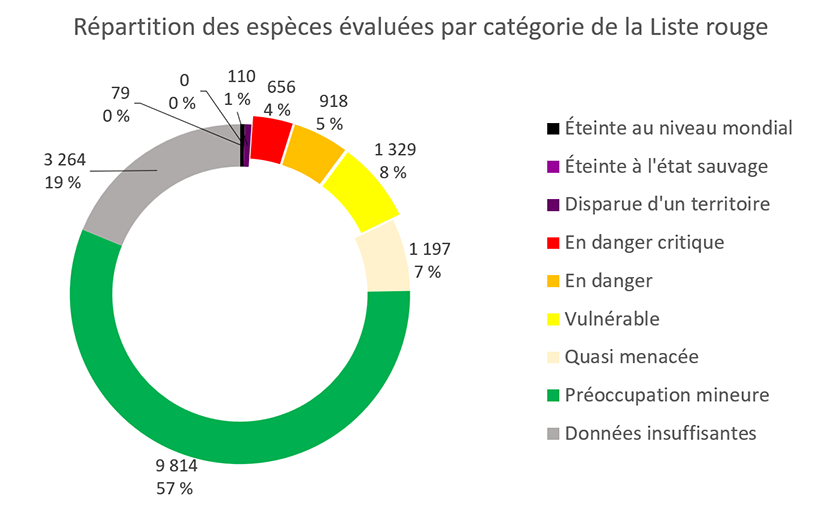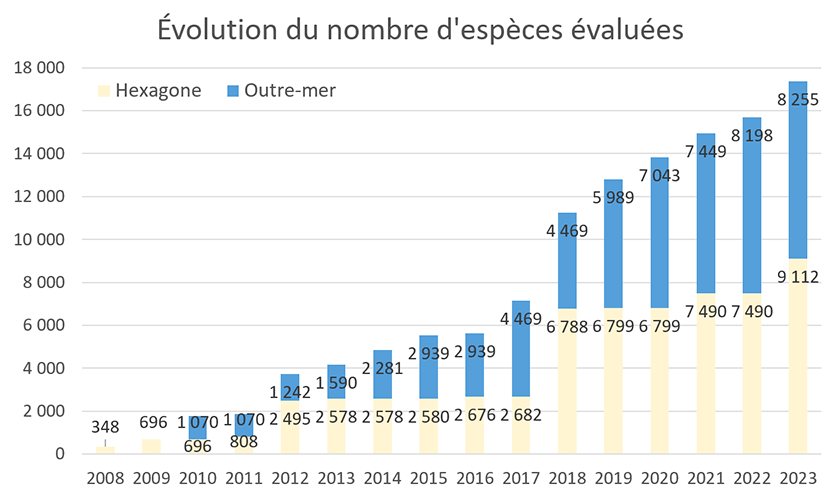
UCN's Red List is the the most comprehensive global assessment of the risk of extinction of species or subspecies of plants and animals. For this purpose, it relies on a series of specific criteria based on the best available scientific knowledge. It aims to identify the conservation priorities, to guide political decisions towards biodiversity and to gain public awareness on the importance and the challenges of current conservation issues.

Megaptera novaeangliae (Borowski, 1781) © Libre de droits & Iberolacerta bonnali (Lantz, 1927) © F. Serre Collet
Within the framework of the Convention on Biological Diversity (CBD), the States agreed to reduce significantly the rate of biodiversity loss before 2010 (International Year for Biodiversity). Since this objective is not achieved, the United Nations launched a new strategy for the 2011-2020 period. In order to measure the progress made, the Red List has been selected as the benchmark to monitor the degree of threat to the species at the global level.
In France, the government has implemented the first National Biodiversity Strategy (NBS) over the same period, and therefore coming to an end in 2010, in order to meet the commitments of the CBD. The State subsequently introduced on May 19, 2010 the new 2011-2020 strategy. As in the previous, the protection of species is one of the most important components of the NBS and the Red List was chosen as a monitoring indicator of the threats to the species at a national level as it has been on a global level. The Muséum national d'Histoire naturelle (MNHN) has been commissioned by the Ministry in charge of the Environment to achieve the national endangered species list. This project is led jointly by the PatriNat unit, of the OFB and the MNHN, and by the IUCN French committee, with the involvement of key organizations in the expertise of species in France. They both implement the project, conduct the assessments and ensure the correct application of the method developed by the IUCN International.
The project is organized into taxonomic sections (mammals, vascular plants, etc.) and geographic sections (metropolitan, Réunion, Guadeloupe, etc.), with the aim to address all the species living on the national territory.

Follow-up table of completed chapters © MNHN, OFB & Comité français de l'UICN
Download the follow-up table of the completed chapters
The development of the Red List of endangered species in France is carried out by the IUCN's French Committee and the Muséum national d'Histoire naturelle (MNHN), in cooperation with many organizations.
It is divided into taxonomic sections (mammals, vascular plants, rhopalocera...) and geographic sections (metropolitan, Réunion, Guadeloupe...). To carry out the assessment of the Red List, organizations with expertise and reliable data on conservation status of species are associated. The expertise of many naturalists and scientists is sought. The achievement of the national Red List is therefore based on a partnership approach and a collegial validation of results.
The list of species to be assessed is established consistently with the national repository (TaxRef) and the best available data are collected to conduct the assessment using the method of the International Union for Conservation of Nature (IUCN). Once confirmed, the results are published and disseminated on the sites of IUCN France and the INPN.
The Red List is a reference inventory that helps to measure the scale of the stakes, the progress made and the incoming challenges for the conservation of species in France.

Distribution of species evaluated by Red List category

Evolution of the number of species evaluated

Sclerotheca raiateensis (Baill.) Pillon & Florence, 2018 © Frédéric Jacq & Lycaena alciphron gordius (Sulzer, 1776) © P. Peyrache
Following the launch of the national project in 2007, many regions wanted to engage in the implementation of regional Red Lists in order to guide their public conservation policies. To support their efforts, the Muséum national d'Histoire naturelle (MNHN), the IUCN's French Committee, the national botanical conservatories federation and the France Nature Environnement federation have partnered in the implementation of a support project to the development of regional Red Lists in metropolitan France, overseas territories being processed as part of the national project.
The different purposes through this support project are to foster the creation and the development of regional Red Lists based on a common methodology, to provide the stakeholders with a methodological support to carry them out and to guide the use of red lists in conservation policies and strategies.
For this purposes, the partners have been assigned with the different background activities and those planned by the end of 2012 as part of the project. Each partner will provide support and guidance for the application of the methodology, will monitor the project and will disseminate the necessary information to the relevant networks. Specifically, the IUCN's French Committee drafted a practical guide addressing the application of IUCN's methodology ( downloadable here ) and the MNHN will provide the taxonomic repository to the relevant stakeholders ( downloadable here ). Other actions will be developed as the program progresses.
Now in the INPN, download the regional Red lists of threatened species results in the Data search pages.
Please fill the transmission form and relay your results and data, in the standardized format to this email adress.
For more information, consult the regional Red lists dashboard (compiled by French IUCN and FNE).